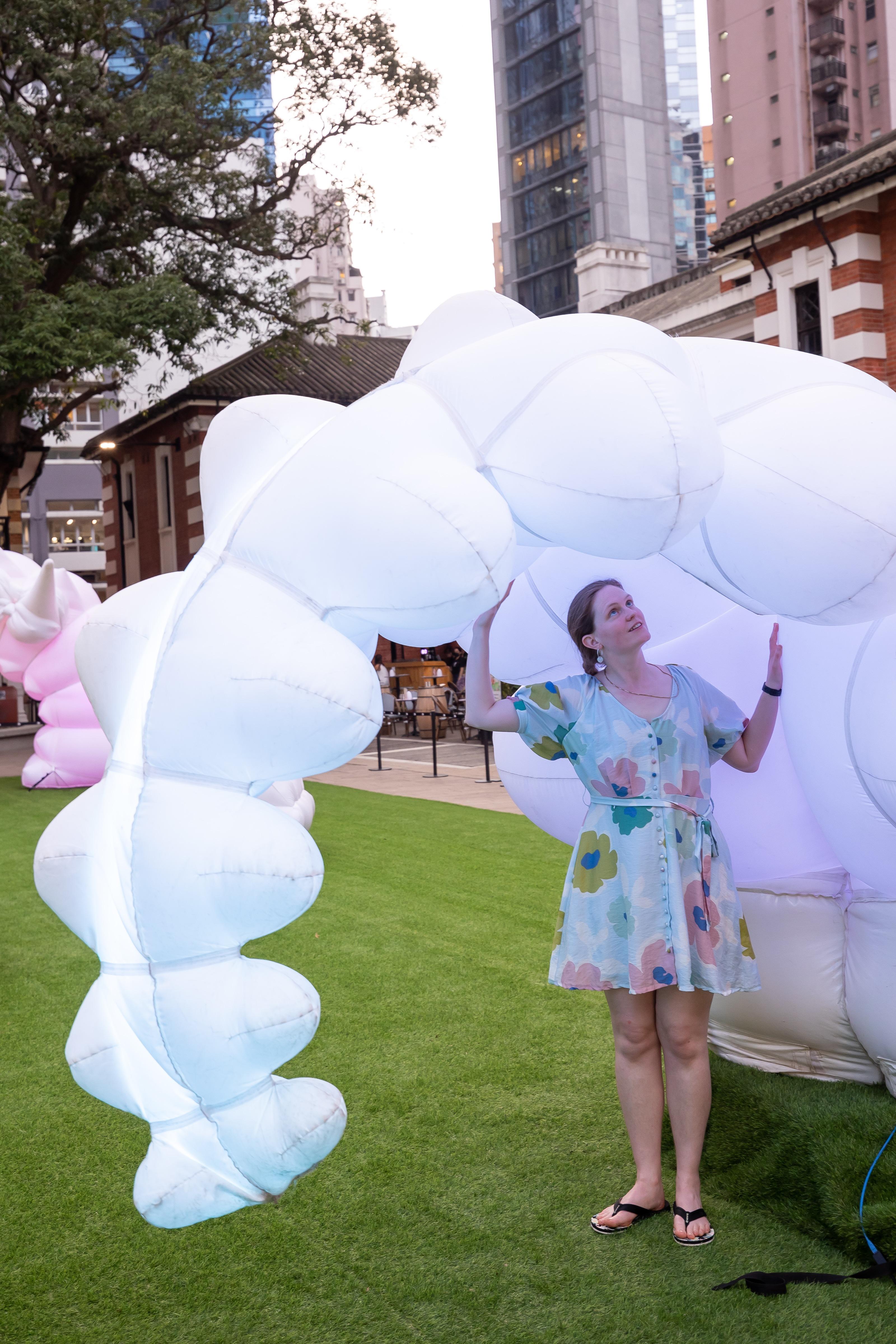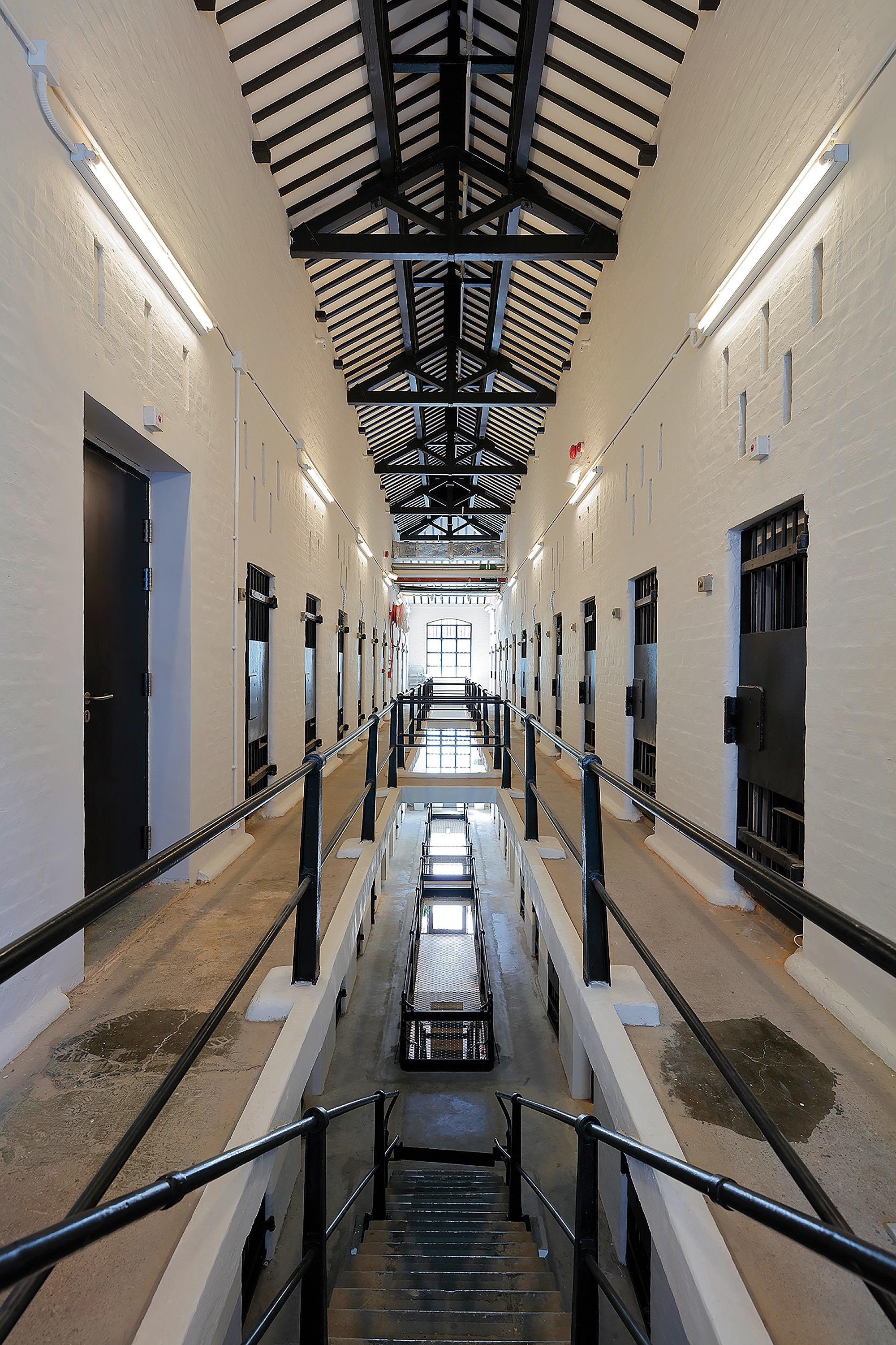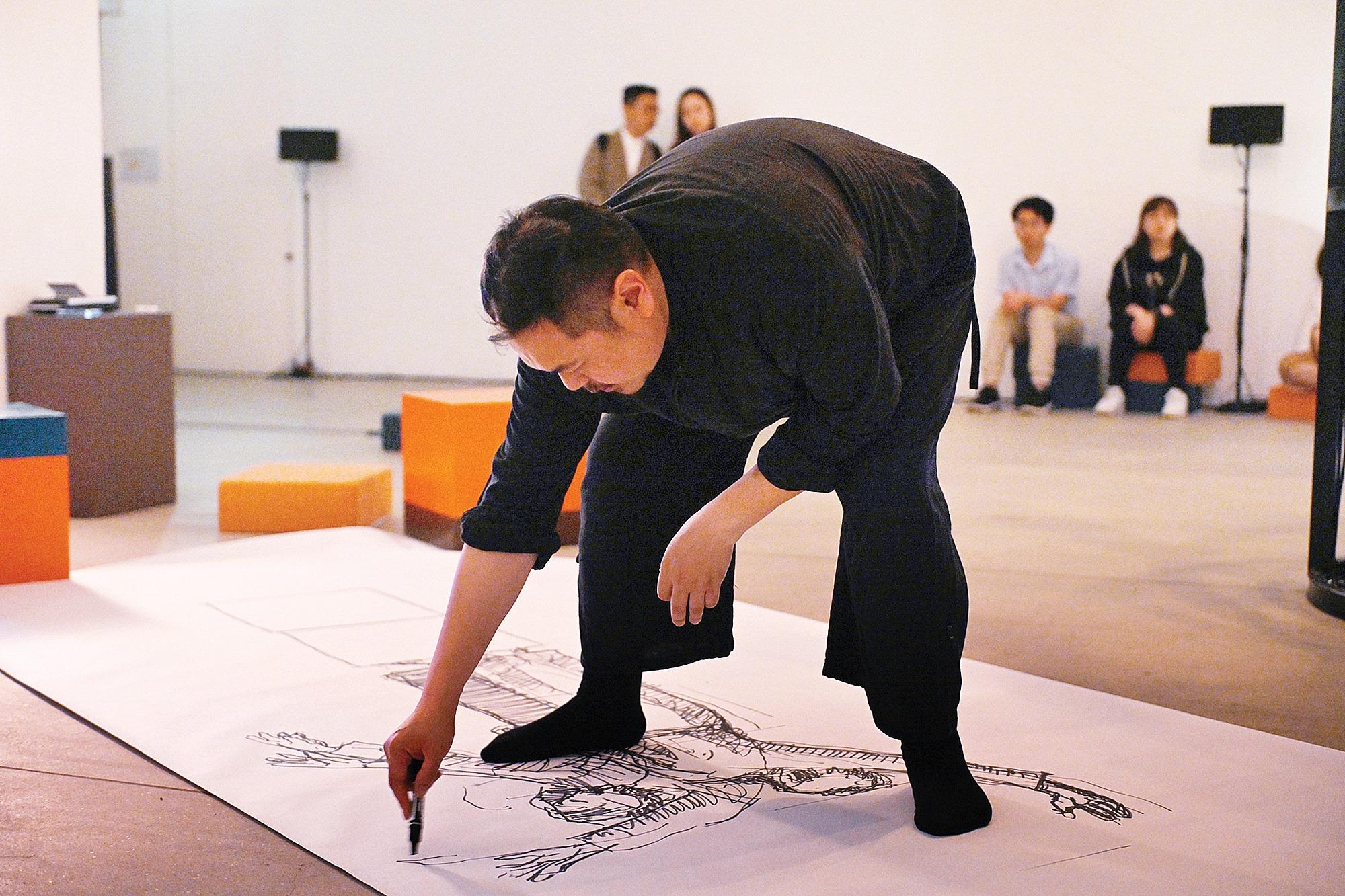Tai Kwun’s unique design — replete with heritage architecture and traces of Hong Kong’s colonial past — is once again under the spotlight in its fifth anniversary year, writes Chitralekha Basu.
 Unfurl, an 18-piece kinetic installation of which nine are inflatable, pneumatically controlled robots, on Tai Kwun’s Parade Ground. (PHOTO PROVIDED TO CHINA DAILY)
Unfurl, an 18-piece kinetic installation of which nine are inflatable, pneumatically controlled robots, on Tai Kwun’s Parade Ground. (PHOTO PROVIDED TO CHINA DAILY)
‘See you in court,” says Ami Ki with a chuckle. A tour guide at the Tai Kwun Centre for Heritage and Arts, she is leading a small group through the free Hidden Spaces Tour. A hush descends on what was once the basement holding area for prisoners on remand, as tour members await their turn to check out the court room of the Central Magistracy. With an all-clear signal from the guide, they file up a narrow, rail-less flight of steps, strictly one at a time, before passing through a trap door to find themselves in the dock.
Hidden Spaces is part of Tai Kwun’s fifth-anniversary celebrations. Once the site of Hong Kong’s Central Police Station, Central Magistracy and Victoria Prison, Tai Kwun’s unique heritage and architecture — sprawling courtyards, imposing masonry walls and colonial-era buildings with red brickwork-and-bone facades — have figured prominently in its programming since the compound was revitalized and adapted into a cultural center in 2018. The anniversary party, which kicked off in the last week of May, similarly draws attention to Tai Kwun’s one-of-a-kind environment and crucial role in Hong Kong’s history, through exhibitions, tours, and a bunch of performance-art programs. Five years since Tai Kwun was turned into a public facility, evidently there is still more to discover.
 Emma Powell of the UK-based Air Giants, who created Unfurl, was delighted with the range of audience responses inspired by the robots in Hong Kong. (PHOTO PROVIDED TO CHINA DAILY)
Emma Powell of the UK-based Air Giants, who created Unfurl, was delighted with the range of audience responses inspired by the robots in Hong Kong. (PHOTO PROVIDED TO CHINA DAILY)
Hidden Spaces, for instance, offered exclusive access to areas of Tai Kwun’s heritage buildings that were opened to visitors for the first time. These included the second floor of E Hall, built in 1915. The tour group was led up a metallic staircase, typical of high-security prisons, for a viewing of the cramped prison cells from narrow passages surrounding the stairwell. Ki noted that for some years before 2006, when Victoria Prison was decommissioned, most of the inmates were remanded prisoners assigned to tasks in the prison’s laundry workshop. The Laundry Steps next to E Hall — now an open-air venue for screenings and performances — used to be a slope to drain the water. The steps were added as part of the site’s revitalization process, begun in 2008.
Hidden Spaces tourists also got the chance to visit an underground tunnel in the Police Headquarters Block. Built as an air-raid shelter in the late 1930s — almost as if in anticipation of the bombing that would destroy some of the buildings in the compound during the Japanese assault on Hong Kong in December 1941 — the 29-meter tunnel takes an unexpected turn, revealing an impossibly tiny hideout. With barely enough space to contain six people, this was meant for top-tier police officers, should Japanese forces infiltrate Tai Kwun and take over. They did.
 The second floor of E Hall and an underground tunnel in the Police Headquarters Block were opened to visitors for the first time to mark Tai Kwun’s fifth anniversary. (PHOTO PROVIDED TO CHINA DAILY)
The second floor of E Hall and an underground tunnel in the Police Headquarters Block were opened to visitors for the first time to mark Tai Kwun’s fifth anniversary. (PHOTO PROVIDED TO CHINA DAILY)
 The second floor of E Hall and an underground tunnel in the Police Headquarters Block were opened to visitors for the first time to mark Tai Kwun’s fifth anniversary. (PHOTO PROVIDED TO CHINA DAILY)
The second floor of E Hall and an underground tunnel in the Police Headquarters Block were opened to visitors for the first time to mark Tai Kwun’s fifth anniversary. (PHOTO PROVIDED TO CHINA DAILY)
Cuddly robots
There were robots at Tai Kwun’s birthday party. Designed by UK-based robotics studio Air Giants, Unfurl is an 18-piece kinetic installation, of which nine are massive, inflatable, pneumatically controlled robots. They are also cuddly and playful — the antithesis of mechanized, creepy and soulless automatons — and had forged a connection with Tai Kwun visitors of all stripes within minutes of their launch.
Emma Powell, co-founder and creative director of Air Giants, was delighted with “the range of audience responses” she came across during Unfurl’s Hong Kong exhibition from May 23-31. People have “stroked, squeezed and bopped” the robots, tried copying their movements, sat under their shade, and even talked to them, she recalls. She also saw a couple of people bowing to the robots, “which I have never seen before!”
She agrees that what makes Unfurl’s Hong Kong iteration unique is its backdrop. Installed in the Parade Ground — Tai Kwun’s main courtyard, girdled on all sides by majestic, late-Victorian and Edwardian architecture — the enormous, soft sculptures that bend and twirl in response to human presence “make the space immediately welcoming and accessible”, Powell says. “Visually, the clean lines of the architecture sit in stark contrast against Unfurl’s undulating and wiggling; it’s stunning.”
 The Butterfly Island dancers line up against the backdrop of F Hall, which used to be a reception and fingerprinting office for prisoners before Victoria Prison was decommissioned in 2006. (PHOTO PROVIDED TO CHINA DAILY)
The Butterfly Island dancers line up against the backdrop of F Hall, which used to be a reception and fingerprinting office for prisoners before Victoria Prison was decommissioned in 2006. (PHOTO PROVIDED TO CHINA DAILY)
Total immersion
Though not listed as an anniversary program, Tai Kwun’s Spotlight series of theater, dance and cross-disciplinary shows that ran from April to May was a celebration of the site’s potential as a nontraditional performance space.
Since When, for example, was spread out across five venues: the Prison Yard, Laundry Steps, a sitting-out area with a multitude of large potted plants, the JC Cube theater, and three flights of stairs leading to it. Chow Yiu-fai, who co-created the experience with composer Joyce Tang and also wrote the lyrics, stood at the top of the steps in his pajamas, next to a blue taxi, handing out “receipts for the things they have lost” to the audience on their way in. The plants hid a sound installation, playing recordings of sounds likely to disappear in the next 20 years, collected by Chow’s students. The young choir made up of students and alumni of the Hong Kong Academy for Performing Arts blended in with the audience as they performed the prologue standing at different levels around the stairwell.
 Since When, a multidisciplinary, multivenue show, starts with co-creator and lyricist Chow Yiu-fai handing out “receipts for the things they have lost” to audience members. (PHOTO PROVIDED TO CHINA DAILY)
Since When, a multidisciplinary, multivenue show, starts with co-creator and lyricist Chow Yiu-fai handing out “receipts for the things they have lost” to audience members. (PHOTO PROVIDED TO CHINA DAILY)
Chow says that one of the challenges of putting on a multi-location show is ensuring that the audience picks up on cues regarding where to go and when; pulling off a seamless “transition from a relatively quotidian outdoor setup to a more fantastical, opaque and dramatic one inside the theater” being another.
Spotlight also featured Butterfly Island, whose eight performers were scattered across the Prison Yard, doing their own acts, simultaneously, in their designated booths. Next, they wrapped themselves in shiny, black-plastic sheets, and started crawling across the yard. He Qiwo, aka Er Gao, who wrote and directed the piece, says the crawling performers represent the waves of the sea.
The potential risks of crawling around in a space where people have free and unregulated access were discussed during rehearsals. The director’s brief to the performers was to be imaginative in their interactions with the public, including in the event that any of them got in the way.
 Chow Chun-fai (above) paints as Gigi Yang articulates the different states of a tree in the middle of a concrete jungle. (PHOTO PROVIDED TO CHINA DAILY)
Chow Chun-fai (above) paints as Gigi Yang articulates the different states of a tree in the middle of a concrete jungle. (PHOTO PROVIDED TO CHINA DAILY)
 Chow Chun-fai paints as Gigi Yang (above) articulates the different states of a tree in the middle of a concrete jungle. (PHOTO PROVIDED TO CHINA DAILY)
Chow Chun-fai paints as Gigi Yang (above) articulates the different states of a tree in the middle of a concrete jungle. (PHOTO PROVIDED TO CHINA DAILY)
Choreographed and danced by Gigi Yang, The Forgiving Trees invited the audience to explore the features of the venue as they took in the performance. Staged at F Hall, which used to be the reception and fingerprinting office for prisoners, the show also featured live art by Chow Chun-fai. As soon as it was finished, the scroll bearing Chow’s drawing of a Hong Kong urban landscape was suspended horizontally from F Hall’s double-height ceiling, creating a fresh backdrop for Yang to perform against.
“Our intention was to construct a space, physical and mental, in which audiences encounter their own stories,” says Joanna Lee, the show’s producer. “Not having a designated space for the audience to sit or stand in is a creative choice that ties in with our invitation to them to get immersed in the performance.”
“The performers do not see their proximity to the audience as a form of ‘pressure’,” she adds. “Instead, it is such proximity that reminds performers of their own presence on the scene — an awareness that’s vital to any performance.”
Contact the writer at basu@chinadailyhk.com
 |
 |
CHINA DAILY HONG KONG NEWS |
OPEN |